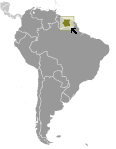World Atlas: Suriname. On this page you can see the map, country flag and many detailed information about the people, history and economy of Suriname.

Here you can find online selected information about the geography, inhabitants, government, economy and history of Suriname. Included are selected statistics, an overview map and the detailed map of Suriname. But let's start with the flag of Suriname here:
Suriname - Overview:
What you should know about Suriname? Let's start with this: First explored by the Spaniards in the 16th century and then settled by the English in the mid-17th century, Suriname became a Dutch colony in 1667. With the abolition of African slavery in 1863, workers were brought in from India and Java. The Netherlands granted the colony independence in 1975. Five years later the civilian government was replaced by a military regime that soon declared Suriname a socialist republic. It continued to exert control through a succession of nominally civilian administrations until 1987, when international pressure finally forced a democratic election. In 1990, the military overthrew the civilian leadership, but a democratically elected government - a four-party coalition - returned to power in 1991. The coalition expanded to eight parties in 2005 and ruled until August 2010, when voters returned former military leader Desire Bouterse and his opposition coalition to power. President Bouterse was reelected unopposed in 2015.
Geography of Suriname
 Where on the globe is Suriname? The location of this country is Northern South America, bordering the North Atlantic Ocean, between French Guiana and Guyana. Total area of Suriname is 163,820 sq km, of which 156,000 sq km is land. So this is not a large country. How could we describe the terrain of the country? This way: mostly rolling hills; narrow coastal plain with swamps. The lowest point of Suriname is unnamed location in the coastal plain -2 m, the highest point Juliana Top 1,230 m. And the climate is tropical; moderated by trade winds.
Where on the globe is Suriname? The location of this country is Northern South America, bordering the North Atlantic Ocean, between French Guiana and Guyana. Total area of Suriname is 163,820 sq km, of which 156,000 sq km is land. So this is not a large country. How could we describe the terrain of the country? This way: mostly rolling hills; narrow coastal plain with swamps. The lowest point of Suriname is unnamed location in the coastal plain -2 m, the highest point Juliana Top 1,230 m. And the climate is tropical; moderated by trade winds.
Inhabitants of Suriname
Let's take a look how many people live in Suriname. The number is: 591,919 (July 2017 est.). So not so many people live here. Who lives here? Hindustani (also known locally as "East Indians"; their ancestors emigrated from northern India in the latter part of the 19th century) 27.4%, "Maroon" (their African ancestors were brought to the country in the 17th and 18th centuries as slaves and escaped to the interior) 21.7%, Creole (mixed white and black) 15.7%, Javanese 13.7%, mixed 13.4%, other 7.6%, unspecified 0.6% (2012 est.). What are the languages in Suriname? Dutch (official), English (widely spoken), Sranang Tongo (Surinamese, sometimes called Taki-Taki, is the native language of Creoles and much of the younger population and is lingua franca among others), Caribbean Hindustani (a dialect of Hindi), Javanese. And the religions: Protestant 23.6% (includes Evangelical 11.2%, Moravian 11.2%, Reformed .7%, Lutheran .5%), Hindu 22.3%, Roman Catholic 21.6%, Muslim 13.8%, other Christian 3.2%, Winti 1.8%, Jehovah's Witness 1.2%, other 1.7%, none 7.5%, unspecified 3.2% (2012 est.). How old are the people in average? 29.8 years. We have to add that this number is the median - so one half of the people is older than this, one half is younger. And what is their life expectancy (at birth)? This: 72.5 years. Where the people live in Suriname? Here: population concentrated along the nothern coastal strip; the remainder of the country is sparsely populated. The major urban areas of Suriname are: Paramaribo (capital) 234,000 (2014).
Government and Economy of Suriname
The capital of Suriname is Paramaribo and the government type presidential republic. Let's take a look at the administrative divisions - 10 districts (distrikten, singular - distrikt); Brokopondo, Commewijne, Coronie, Marowijne, Nickerie, Para, Paramaribo, Saramacca, Sipaliwini, Wanica. Regarding the economy of Suriname, important industrial products are bauxite and gold mining, alumina production; oil, lumbering, food processing, fishing. Important agricultural products are rice, bananas, palm kernels, coconuts, plantains, peanuts; beef, chickens; shrimp; forest products. The most important export commodities are alumina, gold, crude oil, lumber, shrimp and fish, rice, bananas and the most important export partners are Switzerland 28.3%, UAE 27.1%, Belgium 9.1%, Guyana 9%, US 4.7%, Trinidad and Tobago 4.5% (2016). The most important import commodities are capital equipment, petroleum, foodstuffs, cotton, consumer goods and the most important import partners are US 21.2%, Netherlands 10.9%, China 10.5%, Trinidad and Tobago 10.1%, St. Lucia 7% (2016). How rich is Suriname and how rich are people in this country? The most important number here is GDP per capita (PPP): $13,900 (2017 est.). This is quite good. Let's add that this means Gross Domestic Product per person, which is recalculated with respect to the relative cost of local goods and services. And one more important number - population below poverty line: 70% (2002 est.).